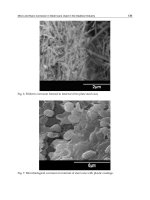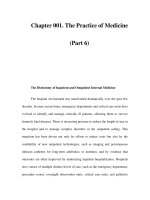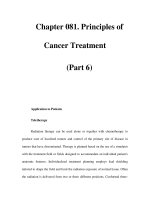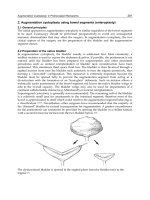Atlas of the Diabetic Foot - part 6 ppsx
Bạn đang xem bản rút gọn của tài liệu. Xem và tải ngay bản đầy đủ của tài liệu tại đây (892.63 KB, 22 trang )
Neuro-Ischemic Ulcers at Various Sites 113
Figure 6.12 Neuro-ischemic ulcers on the hindfoot
revealed significant diffuse stenoses mainly
of the arteries in the left leg.
The patient had two painful superficial
ulcers on the medial aspect of his right
foot due to trauma from his footwear,
which he first noticed 3 months earlier.
He used topical povidone iodide with no
improvement.
The ulcers were clean without signs of
infection. A mild callus had formed as
a result of shoe friction. At the clinic
the ulcers were debrided on a weekly
basis and dressed with standard gauge
with 15% saline. They healed completely
in 1 month. Povidone iodide was dis-
continued as it impairs wound healing.
Instruction in appropriate foot care and
foot hygiene was provided, and suitable
footwear was prescribed.
Neuro-ischemic ulcers comprise almost
40% of all diabetic foot ulcers. Ischemic
ulcers develop at sites which are not
stressed by high pressure, such as the lat-
eral, medial or dorsal aspect of the foot
and are usually painful. Intervention with
vascular surgery (bypass grafting or percu-
taneous transluminal angioplasty) is usually
needed in order to restore the blood supply
to the periphery.
Keywords: Peripheral vascular disease;
neuro-ischemic foot ulcers; pes planus
NEURO-ISCHEMIC ULCER
ON THE FIRST
METATARSAL WITH
OSTEOMYELITIS
An ostensibly small, painless neuro-isch-
emic ulcer on the medial-plantar area of
the first metatarsal head with callus forma-
tion and purulent discharge was the reason
for this patient’s visit (Figure 6.13). Claw
deformity of lesser toes was present. After
debridement, a 1.5 × 1.0 × 1.0cm ulcer
was revealed. A plain radiograph showed
osteomyelitis of the first metatarsal head.
Staphylococcus aureus was isolated from
114 Atlas of the Diabetic Foot
Figure 6.13 An ostensibly small neuro-ischemic ulcer complicated by osteomyelitis. Claw
deformity of lesser toes is also apparent
the discharge and the patient was treated
with clindamycin for 6 months, with a good
outcome.
Keywords: Neuro-ischemic ulcer; osteo-
myelitis
NEURO-ISCHEMIC ULCERS
ON THE MIDSOLE
AND HEEL
After surgical debridement this diabetic
patient suffered from two painful neuro-
ischemic ulcers on the right midsole and
the medial aspect of the heel (Figures 6.14
and 6.15). Cellulitis around the plantar
ulcer was observed. Pedal pulses were
weak and the ankle brachial index was
0.7. The ulcers resulted from ruptured blis-
ters which had developed after prolonged
walking in new shoes. Initially the ulcers
were painless due to peripheral neuropathy,
and the patient continued his activities.
An angiogram showed mild atheromatous
disease at the iliac and common femoral
artery, severe stenosis in the middle of the
right superficial femoral artery and a lesser
degree of stenosis in the popliteal arteries.
Balloon angioplasty of the right superfi-
cial femoral artery was carried out and an
intravascular stent was inserted. Use of a
wheelchair to offload pressure, adequate use
of various antibiotics and a revasculariza-
tion procedure resulted in complete healing
of the ulcers.
Keywords: Neuro-ischemic ulcers
NEURO-ISCHEMIC ULCER
ON THE FOREFOOT WITH
OSTEOMYELITIS
A 64-year-old male patient with type 2 dia-
betes that had been diagnosed at the age
Neuro-Ischemic Ulcers at Various Sites 115
Figure 6.14 The deep neuro-ischemic ulcer with surrounding cellulitis on the right sole resulted
from ruptured blisters which developed after prolonged walking in new shoes
Figure 6.15 Heel ulcer in the patient whose foot is shown in Figure 6.14. The yellowish
appearance of the bed of the ulcer is indicative of ischemia
116 Atlas of the Diabetic Foot
of 55 years, was referred to the outpatient
diabetic foot clinic because of an infected
chronic ulcer on his left foot. The patient
had a history of heart failure, ischemic heart
disease and stage II peripheral vascular dis-
ease (intermittent claudication) according to
the Fontaine classification (see Chapter 1).
He also reported burning pain and numb-
ness in his feet which worsened during the
night. Three months earlier, after a long
walk, the patient noticed the appearance of
a small ulcer under his left first metatarsal
head. He did not ask for medical help at
that time since he felt no pain. A yellowish
discharge was present on his socks and the
insole of the left shoe.
On examination, an infected, foul-smell-
ing ulcer was observed under his second
metatarsal head, extending into the second
web space (Figure 6.16). Another ulcer sur-
rounded by callus was also noted under
the first metatarsal head. Peripheral pulses
were weak on both feet. He had find-
ings of severe diabetic neuropathy. After
debridement a purulent discharge emanated
from the deeper tissues of the dorsum
of the foot. A plain radiograph did not
reveal osteomyelitis. A culture of the pus
revealed Staphylocccus aureus. The patient
was afebrile, but he was admitted to the
hospital and treated with i.v. administra-
tion of amoxicillin–clavulanic acid. Two
weeks after his admission osteomyelitis at
the proximal phalanx of the second toe
was diagnosed. The patient sustained a sec-
ond toe disarticulation at the metatarsopha-
langeal joint. The wound healed well, and
the infection subsided completely.
Several relapses of foot ulceration oc-
curred in the following years. The patient
attended the foot clinic erratically and
did not wear appropriate footwear. Two
years after his amputation a new neuro-
ischemic ulcer developed on the midsole
(Figure 6.17) caused by a worn-out insole.
Figure 6.16 An infected neuro-ischemic ulcer
soaked in profound discharge, on the plan-
tar area between the first and the second left
metatarsal heads extending into the second web
space. A second ulcer surrounded by callus is
also seen under the first metatarsal head
A new neuro-ischemic ulcer under his first
metatarsal head was also present. There was
callus formation below his disarticulated
second toe.
Refusal to wear suitable footwear is a
major problem in patients at risk for foot
ulcers. Although there is evidence to sug-
gest that the correct footwear reduces the
incidence of foot ulcers, and many health-
care systems cover 70–100% of the cost
of preventive footwear (shoes and insoles),
only 20% of patients wear appropriate
footwear on a regular basis. Effective edu-
cation may increase this rate. In addition,
the recurrence of ulcers after initial heal-
ing is also common. A recurrent ulcer is
Neuro-Ischemic Ulcers at Various Sites 117
Figure 6.17 The same patient whose foot is
illustrated in Figure 6.16, two years after sec-
ond toe disarticulation. A neuro-ischemic ulcer
caused by a worn-out insole is seen on mid-
sole. A recurrent neuro-ischemic ulcer is present
under the first metatarsal head. A callus has
formed below the disarticulated second toe
defined as any tissue breakdown at the same
site as the initial ulcer occurring during the
30 days following the initial healing. Any
new ulcer that occurs at the same site within
30 days of healing is considered to be part
of the original episode. An ulcer at a differ-
ent site is considered to be a new episode
independent of the time of its development.
New ulcers develop at the same or different
sites in a foot with prior foot ulceration in
about 50% over 2–5 years. Thus the heal-
ing of an ulcer is just the first step in the
management of the patient at risk. Appro-
priate education, prescription of the correct
footwear and reduction — if possible — of
the risk factors for foot ulceration (cor-
rection of foot deformities, regular callus
removal, improvement in vascular supply to
the feet), may reduce the risk for recurrence
of foot problems in patients with diabetes.
Keywords: Neuro-ischemic ulcer; recur-
rent ulcers; compliance with suitable
footwear
NEURO-ISCHEMIC ULCER
ON THE HALLUX WITH
OSTEOMYELITIS
A 76-year-old female patient with type 2
diabetes diagnosed at the age of 62 years,
attended the outpatient diabetic foot clinic
for a chronic ulcer on the right hallux. She
had a history of ischemic heart disease and
peripheral vascular disease.
On examination she had findings of
peripheral neuropathy. Pedal pulses were
weak on both feet. The patient had a
painful neuro-ischemic ulcer with dimen-
sions 1.0 × 1.0 × 0.4 cm and a sloughy
base on the medial aspect of the right hal-
lux caused by a tight shoe (Figure 6.18).
A plain radiograph revealed osteomyeli-
tis involving the condyle of the proxi-
mal phalanx of the hallux (Figure 6.19).
The ankle brachial index was 0.6. Duplex
ultrasonography of the arteries of the legs
revealed multilevel bilateral atherosclerotic
disease in her superficial femoral arter-
ies and severe stenosis in the arteries of
her left tibia. The pedal arteries were not
involved. The patient underwent a femoro-
popliteal and a popliteal-peripheral bypass.
Since sharp debridement of the ulcer was
too painful, a dextranomer was applied
for mechanical debridement on a daily
basis. A swab culture and a culture of
118 Atlas of the Diabetic Foot
Figure 6.18 Neuro-ischemic ulcer with a sloughy base on the medial aspect of the right hallux
Figure 6.19 Osteomyelitis of the condyle in the proximal phalanx of the hallux of the foot shown
in Figure 6.18
Neuro-Ischemic Ulcers at Various Sites 119
the sequestrum seen in a plain radiograph
revealed Pseudomonas aeruginosa and the
patient was treated with ciprofloxacin. With
local wound care and antibiotic treatment
the ulcer healed completely in 12 weeks
(Figure 6.20). She continued with antibiotic
treatment for a total of 6 months.
Inadequate blood supply prevents heal-
ing of foot ulcers especially when they are
complicated by osteomyelitis.
Debridement of an ulcer is the corner-
stone of the management of active, acute
or chronic wounds. The aim of debride-
ment is to remove fibrin (white, yellow or
green tissue seen on the bed of an ulcer)
and necrotic tissue (black tissue) and to pro-
duce a clean, well vascularized wound bed.
Types of debridement are as follows:
• Sharp surgical (using scalpels), the gold
standard for wound preparation, removes
both necrotic tissue and microorganisms
• Mechanical (using wet-to-dry dressings,
hydrotherapy, wound irrigation and dex-
tranomers)
• Enzymatic (using chemical enzymes such
as collagenase, papain or trypsin in a
cream or ointment base)
• Autolytic debridement (using in vivo
enzymes which self-digest devitalized
tissue such as hydrocolloids, hydrogels,
and transparent films)
Callus formation at the borders of neu-
ropathic ulcers should be removed. The
majority of patients with severe diabetic
neuropathy feel no pain, therefore exten-
sive sharp debridement or even opera-
tions on the feet can be performed with-
out anesthesia.
The use of enzymatic debridement is
increasing. Chronic wounds are enzymati-
cally debrided in elderly patients when reg-
ular, sharp debridement is not possible, e.g.
if the necrotic zone is thin; in ulcers with
sinuses; and as an additional procedure to
sharp debridement. Combination of colla-
genase with hygrogels or alginates seems
to have synergistic effects.
Autolytic debridement uses the body’s
own enzyme and moisture to re-hydrate,
soften and finally liquefy hard eschar and
slough. It is selective, as only the necrotic
tissue is liquefied, and painless to the
patient. Its main indication is non-infected
ulcers with mild to moderate exudates.
Autolytic debridement can be achieved with
the use of occlusive or semi-occlusive
dressings which maintain the wound fluid
in contact with the necrotic tissue. (For a
more detailed description of the different
types of dressings and their indications see
Chapter 2.)
The use of sterile maggots (biosur-
gery, larval therapy, maggot debridement
Figure 6.20 The final stages of ulcer healing in the foot shown in Figures 6.18 and 6.19.Note
the chronic onychomycosis of the hallux with brown discoloration and thickening of the nail
120 Atlas of the Diabetic Foot
Figure 6.21 Neuro-ischemic ulcers on
the dorsum of claw toes
Figure 6.22 Commercially-available
preventive footwear with high toe box
and minimal seaming for forefoot defor-
mities
Neuro-Ischemic Ulcers at Various Sites 121
therapy) is a practical and highly cost-
effective alternative to conventional dress-
ings or surgical intervention in the treat-
ment of sloughy or necrotic wounds. It
is also a valuable tool in cases where
wounds have been infected with antibiotic-
resistant pathogens.
All chronic wounds are contaminated
with bacteria. Studies have shown that a
burden of 1.0 × 10
6
colony-forming units
per gram of tissue can cause signifi-
cant tissue damage and impair healing.
The use of cadexomer iodide decreases
microbial load, and is particularly use-
ful in the treatment of wounds colo-
nized by methicillin-resistant Staphylococ-
cus aureus, Pseudomonas aeruginosa or
Candida albicans.
Other local antimicrobials are also effec-
tive against a wide range of common
microorganisms.
Keywords: Neuro-ischemic ulcer; osteo-
myelitis; types of debridement
NEURO-ISCHEMIC ULCERS
ON THE DORSUM OF CLAW
TOES
Severe claw toe deformity, combined with
peripheral diabetic neuropathy and vascu-
lar disease, predisposes to ulceration of the
dorsum of the toes after repetitive trauma
due to irritation of the thin skin by inap-
propriate shoes (Figure 6.21). The use of
extra depth shoes such as those shown in
Figure 6.22, in addition to basic foot care,
should be sufficient to ensure ulcer healing
and prevention of recurrence, provided the
ulcers are not infected Non-invasive vascu-
lar testing of this patient revealed multilevel
stenosis of the arteries in both legs. The
patient was referred to the vascular surgery
department.
Keywords: Neuro-ischemic ulcers on the
dorsum of toes; preventive footwear; claw
toes
NEURO-ISCHEMIC ULCER
WITH OSTEOMYELITIS
OVER THE FIFTH
METATARSAL HEAD
A 49-year-old male patient with a 4-year
history of type 2 diabetes being treated
with gliclazide, and an 8-year history of
multiple sclerosis, was admitted because of
mild fever and ulcers on his right foot.
He had sustained an amputation of the last
two phalanges of his right fifth toe 2 years
before admission.
Figure 6.23 Neuro-ischemic ulcers on the
right foot over the fifth and first metatarsal
heads. The last two phalanges of the fifth toe
have been amputated and there is a superfi-
cial ulcer on the dorsum of the second toe.
Onychodystrophy is due to peripheral vascu-
lar disease
122 Atlas of the Diabetic Foot
On examination he had a temperature of
37.9
◦
C, a pulse rate of 82 pulses per minute
and his blood pressure was 140/80 mmHg.
An infected ulcer was present on the upper
aspect of his foot over the base of his
amputated toe, and a second one over the
plantar aspect of the fifth metatarsal head
(Figure 6.23). He had hypoesthesia in both
feet, and absence of pulses in his right leg
and foot. There were pulses in his left foot
and both femoral arteries. Achilles tendon
reflexes were reduced and he had a Babin-
ski sign on the right foot. His white blood
cell count was 12,200/mm
3
with 74.7%
neutrophils. His erythrocyte sedimentation
rate was 38 mm/h. Blood glucose was
188 mg/dl (10.4 mmol/l) and his HbA
1c
was 7.5%. Protein was present in a urine
Figure 6.24 X-ray of the foot shown in Fig-
ure 6.23. There is osteomyelitis in the fifth
metatarsal head and the distal phalanges of the
fifth toe have been amputated
sample. An X-ray revealed osteomyelitis of
the head of the fifth metatarsal, right under
the ulcerated area (Figure 6.24). The patient
was treated empirically with clotrimoxazole
and clindamycin. Strenotropomonas mal-
tophilia was isolated from a swab culture
Figure 6.25 Arteriography of the patient
whose foot is shown in Figure 6.23.Thereis
severe obstruction of the distal part of the right
femoral and popliteal arteries; the pedal arteries
are patent and filled by collateral circulation
Neuro-Ischemic Ulcers at Various Sites 123
and netilmicin was added to the treatment
regimen after the antibiogram.
An angiogram revealed severe obstruc-
tion of the lower right femoral and popliteal
arteries (Figure 6.25). Vascular surgeons
suggested a femoro-tibial bypass graft after
his general condition had been stabilized
for several months, or in the case of an
emergency, since no gangrene was present
at the time. Pentoxyphillin and buflomedil
were prescribed. The ulcer improved after
2 weeks of antibiotic treatment and local
care.
Keywords: Neuro-ischemic ulcer; angiog-
raphy; osteomyelitis
Chapter VII
GANGRENE
DRY GANGRENE OF TOES
DRY GANGRENE WITH ISCHEMIC NECROSIS
OF THE
SKIN
DRY GANGRENE OF HEEL
DRY GANGRENE OF ALL TOES
W ET GANGRENE AND SEPSIS
DRY GANGRENE OF THE TOE
S TENT
DIGITAL SUBTRACTION A NGIOGRAPHY
W ET GANGRENE OF THE TOES
W ET GANGRENE OF THE FOOT
W ET GANGRENE LEADING TO MID-TARSAL
DISARTICULATION
EXTENSIVE WET GANGRENE OF THE FOOT
W ET GANGRENE OF THE HALLUX
Atlas of the Diabetic Foot.
N. Katsilambros, E. Dounis, P. Tsapogas and N. Tentolouris
Copyright © 2003 John Wiley & Sons, Ltd.
ISBN: 0-471-48673-6
Gangrene 127
DRY GANGRENE
OF THE TOES
A 65-year-old male patient with type 2 dia-
betes diagnosed at the age of 61 years and
treated with sulfonylurea, was admitted to
the Vascular Surgery Department. He was a
heavy smoker and had a sedentary lifestyle.
He had hypertension, background diabetic
retinopathy and dyslipidemia (triglycerides:
4 mmol/l; HDL-cholesterol: 0.67 mmol/l).
His diabetes control was poor (HBA
1c
:
8.5%). The patient complained that in the
previous 3 weeks he had experienced pain
which required analgesia when he was at
rest. He had typical symptoms of intermit-
tent claudication for 2 years with progres-
sive worsening.
On examination, extensive dry gangrene
was found involving all the toes and with
a necrotic area over the dorsum of his
left foot (Figure 7.1). The foot arteries
and left popliteal artery could not be felt,
while the femoral arteries were just pal-
pable bilaterally. Pulses in the right foot
arteries were absent; the skin was cold
and the right popliteal artery was just pal-
pable. The ankle brachial index was 0.4.
The patient had reduced sensation of pain,
light touch and temperature. The vibration
perception threshold was 35 V on the left
and 30 V on the right foot. C ritical limb
ischemia with dry gangrene was diagnosed;
an angiogram showed extensive stenosis
of the common iliac, superficial femoral
and popliteal arteries of both feet. Aorto-
femoral and femoro-popliteal bypass grafts
were undertaken 2 days after admission,
followed by mid-tarsal disarticulation (at
Lisfranc’s joint). The postoperative period
was without any complications and the
wound healed completely.
Gangrene is characterized by the presence
of cyanotic, anesthetic tissue associated with
or progressing to necrosis. It occurs when
the arterial blood supply falls below mini-
mal metabolic requirements. Gangrene c an
be described as dry or wet. Wet gangrene is
dry gangrene complicated by infection (see
below, and Figures 7.24 and 7.25).
Dry gangrene is characterized by its
hard, dry texture, usually occurring in the
distal aspects of the toes, often with a clear
demarcation between viable and necrotic
tissue. Once demarcation occurs, as is the
case in this patient, the involved toes may
be liable to auto-amputation. However, this
is a long (several months) and unpleasant
process. In addition, many patients do not
have an adequate circulation to heal a distal
amputation. For these reasons it is common
practice to evaluate the arteries angiograph-
ically and to carry out a bypass or a percu-
taneous transluminal angioplasty with con-
comitant limited distal amputation, in order
to improve the chances of wound healing.
CRITICAL LEG ISCHEMIA
Critical leg ischemia is defined — according
to the c onsensus statement on critical limb
ischemia — as either of the following two
criteria: persistently recurring ischemic rest
pain, requiring regular adequate analgesia
for more than 2 weeks, with an ankle sys-
tolic pressure ≤50 mmHg and/or a toe pres-
sure ≤30 mmHg; or ulceration or gangrene
of the foot or toes, with an ankle systolic
pressure ≤50 mmHg and/or a toe pressure
≤30 mmHg. In such patients it is impor-
tant to differentiate neuropathic pain from
ischemic rest pain (neuropathic pain typi-
cally occurs or worsens at rest in the night).
Measurement of the ankle brachial index
or toe pressure can easily differentiate the
two conditions.
Keywords: Dry gangrene; critical limb
ischemia
128 Atlas of the Diabetic Foot
Figure 7.1 Dry gangrene involving all the toes of the left foot with a necrotic area over the
mid-dorsum. Note the hard, dry texture and the clear demarcation between viable and necrotic
tissue. (Courtesy of E. Bastounis)
Gangrene 129
DRY GANGRENE WITH
ISCHEMIC NECROSIS
OF THE SKIN
Dry gangrene in a female patient with type
2 diabetes, involving the distal parts of
the toes of her right foot is illustrated in
Figure 7.2. The pedal arteries were not pal-
pable and the ankle brachial index was 0.4.
A well-demarcated red area extended up to
the ankle and the lateral foot, indicating
ischemic necrosis of the skin. Angiogra-
phy showed the patient to have multilevel
severe atherosclerotic disease with involve-
ment of the tibial and pedal arteries. An
attempt at mid-tarsal (at Lisfranc’s joint)
disarticulation was unsuccessful, as it was
discovered during the operation that the
deep tissues were all necrotic. Finally, the
patient sustained a below-knee amputation.
Keywords: Dry gangrene
DRY GANGRENE OF HEEL
A 74-year-old female patient with long-
standing type 2 diabetes was admitted to
the hospital because of a stroke. She had
palsy of her left arm and foot. Her hos-
pitalization was complicated by aspiration
pneumonia, which confined the patient to
bed for 2 weeks. The patient had a history
of ischemic heart disease and hypertension.
Peripheral pulses were weak in both feet.
On the sixth day of her hospitalization a
blister with a black base developed on the
posterolateral aspect of her left foot, and it
evolved into an ischemic ulcer and dry gan-
grene (Figure 7.3). A triplex ultrasonogram
revealed extensive severe bilateral stenoses
in the superficial femoral and popliteal
arteries. Revascularization was not possible
Figure 7.2 Dry gangrene o f the distal areas of
the toes of the right foot. The well-demarcated
red area extending up to the ankle and the lateral
foot indicates ischemic necrosis of the skin.
(Courtesy of E. Bastounis)
due to the patient’s general condition. A
heel protector ring was applied so that
the heel was completely suspended off the
bed and sharp debridement was performed.
The ulcer healed after 4 months with daily
foot care.
Pressure ulcers are caused by constant
pressure over bony heel prominences from
an opposing surface such as a mattress. This
results in reduced blood flow in the heel
with soft tissue necrosis and consequent
pressure ulcer development. These ulcers
may account for extended hospitalizations
and they are recognized as both detrimental
to an individual’s quality of life and a finan-
cial burden to the healthcare system. Pres-
sure ulcers of the heel are preventable by
the use of a heel protector ring (Figure 7.4)
or other calf support devices (Figure 7.5).
Since the calf has a large resting surface
130 Atlas of the Diabetic Foot
Figure 7.3 Dry gangrene due to constant pressure under the bony heel prominence
excessive pressure is avoided. In addi-
tion, revascularization should be performed
immediately in patients with heel gangrene,
since such ulcers heal slowly and may
become infected.
Keywords: Heel ulcer; dry gangrene; pres-
sure ulcer; heel protective devices
Figure 7.4 Heel protector ring which keeps
the heel suspended and completely off mattress
DRY GANGRENE
OF ALL TOES
Dry gangrene in a male diabetic patient
involving all the toes is shown in Fig-
ure 7.6. In this patient a bypass graft of
his leg arteries was not possible because
of extensive multilevel disease. The patient
sustained a mid-tarsal (at the Lisfranc’s
joint) disarticulation.
Keywords: Dry gangrene; mid-tarsal dis-
articulation
WET GANGRENE
AND SEPSIS
A 65-year-old male patient who had type
2 diabetes since the a ge of 45 years and
was being treated with sulfonylureas, was
brought to the emergency clinic suffer-
ing from a fever. He had left paraplegia
following a stroke 6 months earlier. One
month before admission the toes of his
left foot became gradually very painful;
Gangrene 131
Figure 7.5 Calf support device which
provides a larger resting surface thus off-
loading pressure from the heel
Figure 7.6 Dry gangrene of all toes
132 Atlas of the Diabetic Foot
Figure 7.7 A black ischemic ulcer on the dorsum of the left second toe, with edema. Note the
whitish tip of the toe due to ischemia. Fungal infection of the thickened nail of hallux with yellowish
discoloration and subungual d ebris is apparent
the patient was usually calm, but occa-
sionally he suffered from bouts of excru-
ciating pain. A general practitioner pre-
scribed cotrimoxazole, pentoxyphyllin and
fentanyl patches.
On examination, the patient was febrile
and his condition was critical. His second
left toe was edematous and painful, with
a black ischemic ulcer on the dorsum; the
tip of the toe was white (Figure 7.7); a
gangrenous pressure ulcer was visible on
the left heel (Figure 7.8), due to lengthy
confinement to bed. Callosity was present
under the right fifth metatarsal head, as
well as onychodystrophy, due to periph-
eral vascular disease. No pulses were pal-
pable on his left foot. Both his calves were
painful to touch. No other site of infec-
tion was found. The patient was classified
as Fontaine stage IV. Osteomyelitis was
not found on the radiographs. Swab c ul-
tures revealed Staphylococcus aureus and
Pseudomonas aeruginosa and the patient
was treated with ciprofloxacin and clin-
damycin. Blood cultures were negative.
On the second day the patient felt better
and became afebrile by the third day of
hospitalization.
A digital subtraction a ngiography, car-
ried out 10 days after admission, showed
80% stenosis of both iliac arteries, and
almost complete obstruction of both super-
ficial femoral arteries (Figure 7.9), while
the popliteal arteries were filled from proxi-
mal collateral circulation (Figure 7.10). The
peripheral arteries had moderate atheroma-
tous disease. Aorto-iliac intravascular stents
were inserted (Figure 7.11).
His second left toe was disarticulated.
Surgical debridement of the heel ulcer was
Gangrene 133
Figure 7.8 Low pressure gangrenous ulcer on the left heel of the foot shown in Figure 7.7
carried out and calf supportive devices
promoted the healing process.
An infected gangrenous area of the foot
and particularly on a toe with bounding feet
pulses is a condition that is sometimes seen.
This is called ‘diabetic gangrene’ and it is
caused by a thrombosis in the toe arter-
ies which is induced by toxins produced
by certain bacteria (mainly staphylococci
and streptococci). Plantar abscesses may
also result in septic arteritis of the plantar
arch and eventually gangrene of the mid-
dle toe.
Keywords: Wet gangrene; sepsis; heel
ulcer; digital subtraction arteriography; dia-
betic gangrene
DRY GANGRENE
OF THE TOE
A 52-year-old woman with type 2 diabetes
mellitus diagnosed at the age of 42 years
and being treated with sulfonylureas, was
referred to the outpatient diabetic foot clinic
134 Atlas of the Diabetic Foot
Figure 7.9 Digital subtraction ang-
iography of the foot illustrated in
Figures 7.7 and 7.8, showing severe
multifocal stenosis of both iliac arter-
ies and almost complete obstruction of
both superficial femoral arteries
for dry gangrene of her right fourth toe. No
other diabetic complications were reported.
She denied intermittent claudication.
A minor painless trauma of the affected
toe was reported 1 week previously and
the toe became black 24 h later. Edema
and redness of the forefoot was reported
and she was treated with cotrimoxazole and
clindamycin, and bed rest. Within a week
the injury became smaller and dried out.
On examination, she had findings of
peripheral neuropathy; the pulses in her
foot arteries were diminished. The ankle
brachial index was 0.5 on the right, and 0.6
on the left side.
The fourth toe was gangrenous and
shrunken, and a neuro-ischemic ulcer was
noted under the head of the third metatarsal.
Scaling of the skin due to edema which had
subsided was also observed and onychodys-
trophy was present (Figure 7.12). Digital
subtraction angiography revealed signifi-
cant stenosis of both proximal iliac arter-
ies, just after the celiac aortic bifurcation
(Figure 7.13). Aortic stents were inserted
at the sites of stenosis, by catheterization
which was carried out by an experienced
radiologist, and the foot circulation was
thus restored (Figure 7.14).
An X-ray of her left foot revealed
an unknown stress fracture in the proxi-
mal phalanx of her fifth toe (Figure 7.15).
Osteoarthritis was also apparent in the first
and fourth metatarsophalangeal joints.
Ten days after stent insertion the fourth
toe was amputated under local anesthesia.
No complications occurred postoperatively,
and the wound healed completely.
Keywords: Dry gangrene; intravascular
stent; stress fracture; revascularization; toe
amputation
Gangrene 135
Figure 7.10 Digital subtraction angiography of the foot illustrated in Figures 7.7–7.9, showing the
popliteal arteries being supplied from extensive proximal collateral v essels. (Courtesy of C. Liapis)
STENT
A 71-year-old male patient was admitted
because of gangrene in his left foot. Dia-
betes mellitus was diagnosed on admis-
sion and he was treated with low doses
of insulin. Antibiotic therapy was initiated,
in addition to pentoxyphillin, prostaglandin
E1 synthetic analog and phentanyl for the
pain. A digital subtraction angiography was
carried out which disclosed multiple sites
of stenosis in both iliac and superficial
femoral arteries (Figure 7.16 upper panel,
and Figure 7.17). A suboptimal angioplasty
was carried out on both arteries and stents
were inserted (Figure 7.16 lower panel, and
Figure 7.18).
During percutaneous transluminal angio-
plasty a balloon catheter is used to increase
the diameter of the lumen of the arterioscle-
rotic artery. This is a quite safe and min-
imally invasive technique (as compared to
surgery); it preserves saphenous veins, and
reduces the length of hospital stay. How-
ever, this procedure fails more often in dia-
betic than in non-diabetic patients due to
intimal hyperplasia.
Stents are used to treat suboptimal angio-
plasty, lesions with severe dissections or
136 Atlas of the Diabetic Foot
Figure 7.11 Post-stent digital subtrac-
tion angiography of foot shown in
Figures 7.7–7.10. (Courtesy of C. Liapis)
Figure 7.12 Dry g angrene of right fourth toe. There is a neuro-ischemic ulcer under the third
metatarsal head









